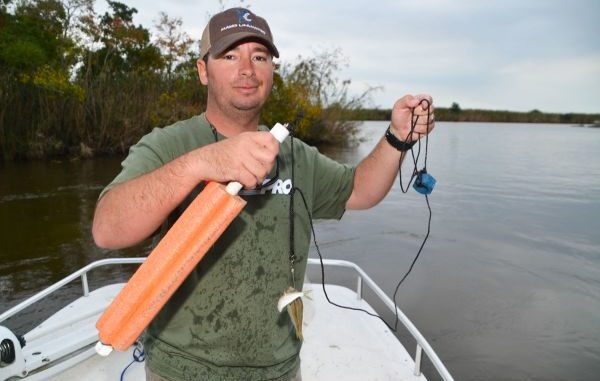
It used to be that a catfish jug was just that — a simple jug that could be a used plastic milk or oil container.
But now catfish jugs have gone uptown, almost high tech. Derek Logan’s jugs are no exception.
He is proud of how his jugs work, but is quick to share credit.
“In my job, I get to see so many people’s fishing and hunting ideas,” Logan said. “I put them all together to come with something that is perfect.”
Every jug starts out with a 19-inch piece of ¾-inch PVC pipe, a 12-inch piece of foam pool noodle (the thing kids have fun with in swimming pools) and a 2-inch piece of steel rebar (concrete reinforcing bar).
The pipe is inserted through the hollow core of the noodle. A PVC cap is glued on one end, and the rebar is dropped into the pipe.
Before the second cap is glued on the other end, Derek drills a hole through it, just large enough to fit an eye bolt through it with the eye on the outside of the cap. Before gluing this cap in place, he puts a dab of the cement around the eye bolt nut to seal the hole.
Approximately 5 feet of stout tarred nylon line is tied to the eye bolt. A weight — a lead bank or pyramid sinker or even a steel nut — is tied to the other end of the line. The weight serves to slow the jug’s drift while it is fishing.
About a foot below the float, Derek forms a 4-inch loop in the line to which he attaches a swivel. He bends open the eye of a 6/0 hook, preferably a kahle (although he also uses some circle and J hooks), enough to put the hook on the other end of the swivel. He then bends the eye shut again.
The swivel is critical, he emphasized, because otherwise hooked catfish will spin and twist, often knotting the line up enough to twist the hooks out of their jaws.
Although this is the ideal line-swivel-hook set-up, Derek’s experiments are obvious in some of his jugs. In a few he has a 3-inch piece of line between the swivel and the hook. In some he has even added yet another swivel to make a swivel-line-swivel-hook set-up. These latter he calls “swivel overkill,” with a chuckle.
He wraps each end of the PVC pipe with high-quality reflective tape, an invaluable aid to finding wayward jugs at night. Good reflective tape is hard to find locally, noted Logan, who orders his from Harbor Freight.
The final step in jug-making is to slide the foam noodle all the way to the end of the pipe opposite the end to which the line is tied. The jug is ready to bait-up and fish.